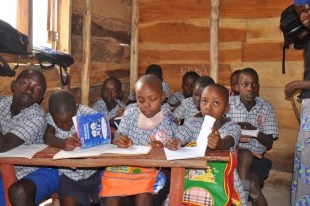For Only $80 a Year, You can provide an Education for a Child at Light Of Hope Children’s Ministry Uganda. We all know just how important an education is for every child…Our School age children go for to school for 3 terms during the year, and it costs $26 per term…and a meal is also included. Our children are just like any other child, just like your children, they long to be taught new things, taught how to read and write, how to spell their names and they dream just like your Child does. We at Light Of Hope Children’s Orphanage believe that we are raising the future leaders of Uganda, and the world! We trust God for everything we do at the orphanage, and He always provides through Sponsors Like yourself…and Our children love and appreciate their sponsors sincerely…We would ask that you prayerfully consider sponsoring one of the Children at Light Of Hope Children’s Ministries education.



SOME FACTS ABOUT EDUCATION IN UGANDA
In Uganda, 7 out of 10 children won’t finish a primary-level education. Most adults haven’t received an education, and therefore don’t see educating their children as important – many prioritize child labor over education. Uganda has one of the lowest primary ‘survival rates’ in East Africa – with just 33% of children starting primary school finishing. On the other hand, Uganda’s neighboring countries have better survival rates; Kenya’s primary survival rate of 84%, Tanzania of 78%, and Rwanda of 81%.
In the Government-run schools, there can be one teacher to look after 100 children, although the average classroom is one teacher to 54 students. Schools are often mud huts with no amenities, air conditioning, or educational materials. Uganda has the world’s youngest population. There are currently over 38 million people living in Uganda, 50% of which are under 14 years old; It means close to 19 million children are running around in Uganda.
What is the Education System in Uganda Like
NURSERY/KINDERGARTEN (DURATION: THREE YEARS)
This is the pre-school level of education in Uganda. Children usually start at the age of three and complete nursery school by the age of six.
PRIMARY SCHOOL / ELEMENTARY SCHOOL (DURATION: SEVEN YEARS)
In Uganda, there are seven primary school years, from primary one to primary seven. With normal annual progression this means primary school should last seven years, but many pupils drop out part way through and return later, so it is not unusual to find teenagers sitting primary exams. At the end of primary seven, pupils sit their first major national exams – the primary leaving examinations (PLE). Presently PLE has four examinable subjects – English language, mathematics, science and social studies. The best possible mark pupils can achieve is a total of four (which means one point – a distinction – in each subject), while the worst is a total of 36 (nine points for each subject, which means a fail). Students with between four and 12 points pass the PLE with a first grade, or division one. Those with scores between 13 and 23 get a second grade; 24 to 29 get a third grade, while those with 30 to 34 pass with a fourth grade.
SECONDARY SCHOOL / HIGH SCHOOL (DURATION: SIX YEARS)
Pupils who pass their PLE can progress to secondary school. This has two stages; the first four years, senior one (S1) to senior four (S4), constitute the O-level period. At the end of S4, students sit the second major national exams known as the Uganda Certificate of Education (UCE) or simply O-level examinations. Students who pass their O-level exams may progress to A-levels or the Higher School Certificate (HSC). This lasts two years, S5 and S6, after which students sit for the Uganda Advanced Certificate of Education (UACE) examinations, also known simply as A-levels. All these three annual national exams are sat between October and December.
UNIVERSITY AND OTHER TERTIARY INSTITUTIONS
Students who pass their A-levels may choose to progress to university, where they can study for degrees, or to other tertiary institutions that award diplomas and certificates. Some wealthier parents send their children to universities and colleges abroad. The government gives about 4,000 university scholarships each year, and sponsors thousands of other students in other tertiary institutions. But tens of thousands of students who do not get the competitive government scholarships depend on their parents and guardians to pay their tuition and upkeep.

